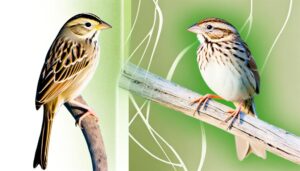7 Key Differences Between Brewer Sparrow Vs Clay-colored Sparrow
Brewer's Sparrow and Clay-colored Sparrow diverge markedly in several aspects. Brewer's Sparrow is slender, 5.1 inches long, with a fine bill suited to small insects and seeds, and streaked gray-brown plumage.
In contrast, Clay-colored Sparrow, at 5.5 inches, has a thicker bill for a varied diet, and pale gray plumage marked by a white crown stripe and buffy malar stripe. Vocalizations differ: Brewer's produces delicate trills, while Clay-colored's song is a rhythmic buzz.
Additionally, Brewer's favors arid, sagebrush landscapes, whereas Clay-colored occupies shrubby grasslands. These differences highlight their unique evolutionary adaptations, offering much more to explore.

Key Takeaways
- Brewer's Sparrow has a slender build and fine bill, while the Clay-colored Sparrow features a robust build and thicker bill.
- Brewer's Sparrow sports streaked brown and gray plumage; Clay-colored Sparrow has pale gray and buff plumage with distinct facial markings.
- Brewer's Sparrow produces delicate, insect-like trills; Clay-colored Sparrow emits a distinctive, buzzy series of notes.
- Brewer's Sparrow inhabits arid, open landscapes with sagebrush; Clay-colored Sparrow prefers shrubby grasslands and open woodlands.
- Brewer's Sparrow exhibits solitary and inconspicuous behavior; Clay-colored Sparrow is social and gathers in larger flocks.
Physical Characteristics

When comparing the physical characteristics of the Brewer's Sparrow and the Clay-colored Sparrow, one observes distinct differences in plumage, size, and markings.
The Brewer's Sparrow generally exhibits a more slender build, measuring around 5.1 inches in length. Its wingspan stretches to about 8 inches, allowing for nimble flight.
In contrast, the Clay-colored Sparrow appears slightly more robust, with a length of approximately 5.5 inches and a wingspan of 7.5 inches. Their bills also show variation; the Brewer's Sparrow has a finer, more delicate bill, aiding in its diet of small insects and seeds.
The Clay-colored Sparrow's bill is marginally thicker, better suited for its varied diet. These subtle differences underscore their adaptation to distinct ecological niches.
Plumage Differences
Observing their plumage, the Brewer's Sparrow displays a subtle, streaked brown and gray pattern, whereas the Clay-colored Sparrow is characterized by a more defined, pale gray and buff coloration with distinct facial markings.
The Brewer's Sparrow's plumage is understated, blending seamlessly into its arid habitats. In contrast, the Clay-colored Sparrow's sharp facial contrasts and clear breast band make it more visually striking.
Key differences include:
- Brewer's Sparrow has fine streaks on the breast and back.
- Clay-colored Sparrow exhibits a prominent white crown stripe.
- Brewer's Sparrow lacks the distinct facial markings found on its counterpart.
- Clay-colored Sparrow shows a clear, buffy malar stripe.
- Brewer's Sparrow's overall coloration is earth-toned, aiding in camouflage.
These differences highlight their unique adaptations and habitats.
Song and Calls

The Brewer's Sparrow produces a delicate, insect-like trill, whereas the Clay-colored Sparrow delivers a distinctive, buzzy series of notes that resemble the sound of a mechanical insect.
The Brewer's Sparrow's song comprises a continuous, high-pitched series of trills, often described as ethereal and subtle. In contrast, the Clay-colored Sparrow's call is characterized by a rhythmic, mechanical buzz, which is more monotone and less melodic.
These differences in vocalization are essential for species identification, especially in overlapping territories. Observers note the Brewer's Sparrow's song as a more complex, musical performance, while the Clay-colored's rendition is straightforward and repetitive.
This divergence in auditory signals reflects evolutionary adaptations for communication and mate attraction within their respective environments.
Habitat Preferences
While their vocalizations serve as auditory markers, Brewer's Sparrow and Clay-colored Sparrow also exhibit distinct habitat preferences that further differentiate these two species. Brewer's Sparrow shows a proclivity for arid, open landscapes dominated by sagebrush. In contrast, the Clay-colored Sparrow favors shrubby grasslands and open woodlands, frequently found in areas with dense undergrowth.
Brewer's Sparrow thrives in sagebrush steppe ecosystems.
Clay-colored Sparrow prefers mixed-grass prairies with scattered shrubs.
Brewer's Sparrow avoids heavily forested regions.
Clay-colored Sparrow often resides in border regions between forests and prairies.
Brewer's Sparrow can be found in dry, high-altitude regions.
These habitat preferences underscore the ecological adaptations each species has developed to optimize survival and reproductive success in their respective environments.
Behavior Patterns

Brewer's Sparrow exhibits a more solitary and inconspicuous behavior compared to the more social and conspicuous Clay-colored Sparrow. Brewer's Sparrow often forages alone or in small groups, displaying a preference for staying low within dense shrubs, minimizing exposure to predators.
In contrast, the Clay-colored Sparrow frequently gathers in larger flocks, especially during migration, and showcases a more assertive foraging strategy, venturing into open spaces. Vocalizations further distinguish them; Brewer's Sparrow emits a soft, buzzing song that blends into the background, while the Clay-colored Sparrow's song is a more distinctive, mechanical trill, easily recognized.
These behavioral differences highlight their adaptation strategies, reflecting their ecological niches and evolutionary paths, offering bird enthusiasts fascinating insights into avian diversity and survival tactics.
Conclusion
To wrap up, distinguishing Brewer's sparrow from the clay-colored sparrow requires a keen eye akin to Sherlock Holmes' meticulous attention to detail. Their subtle plumage variations, distinct vocalizations, and differing habitat preferences serve as critical clues.
Observing their behavior patterns, much like a naturalist on a Galápagos expedition, reveals deeper insights into their unique ecological niches.
Through comparative analysis, one appreciates the intricate tapestry of avian biodiversity, showcasing nature's remarkable adaptability and complexity.






